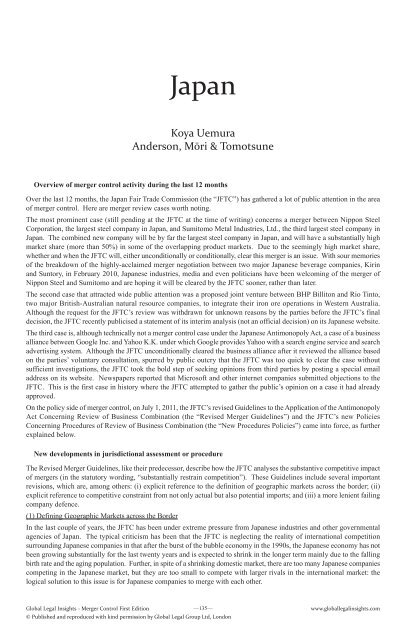Merger Controls First Edition - J Sagar Associates
Merger Controls First Edition - J Sagar Associates
Merger Controls First Edition - J Sagar Associates
You also want an ePaper? Increase the reach of your titles
YUMPU automatically turns print PDFs into web optimized ePapers that Google loves.
Japan<br />
Koya Uemura<br />
Anderson, Mōri & Tomotsune<br />
Overview of merger control activity during the last 12 months<br />
Over the last 12 months, the Japan Fair Trade Commission (the “JFTC”) has gathered a lot of public attention in the area<br />
of merger control. Here are merger review cases worth noting.<br />
The most prominent case (still pending at the JFTC at the time of writing) concerns a merger between Nippon Steel<br />
Corporation, the largest steel company in Japan, and Sumitomo Metal Industries, Ltd., the third largest steel company in<br />
Japan. The combined new company will be by far the largest steel company in Japan, and will have a substantially high<br />
market share (more than 50%) in some of the overlapping product markets. Due to the seemingly high market share,<br />
whether and when the JFTC will, either unconditionally or conditionally, clear this merger is an issue. With sour memories<br />
of the breakdown of the highly-acclaimed merger negotiation between two major Japanese beverage companies, Kirin<br />
and Suntory, in February 2010, Japanese industries, media and even politicians have been welcoming of the merger of<br />
Nippon Steel and Sumitomo and are hoping it will be cleared by the JFTC sooner, rather than later.<br />
The second case that attracted wide public attention was a proposed joint venture between BHP Billiton and Rio Tinto,<br />
two major British-Australian natural resource companies, to integrate their iron ore operations in Western Australia.<br />
Although the request for the JFTC’s review was withdrawn for unknown reasons by the parties before the JFTC’s final<br />
decision, the JFTC recently publicised a statement of its interim analysis (not an official decision) on its Japanese website.<br />
The third case is, although technically not a merger control case under the Japanese Antimonopoly Act, a case of a business<br />
alliance between Google Inc. and Yahoo K.K. under which Google provides Yahoo with a search engine service and search<br />
advertising system. Although the JFTC unconditionally cleared the business alliance after it reviewed the alliance based<br />
on the parties’ voluntary consultation, spurred by public outcry that the JFTC was too quick to clear the case without<br />
sufficient investigations, the JFTC took the bold step of seeking opinions from third parties by posting a special email<br />
address on its website. Newspapers reported that Microsoft and other internet companies submitted objections to the<br />
JFTC. This is the first case in history where the JFTC attempted to gather the public’s opinion on a case it had already<br />
approved.<br />
On the policy side of merger control, on July 1, 2011, the JFTC’s revised Guidelines to the Application of the Antimonopoly<br />
Act Concerning Review of Business Combination (the “Revised <strong>Merger</strong> Guidelines”) and the JFTC’s new Policies<br />
Concerning Procedures of Review of Business Combination (the “New Procedures Policies”) came into force, as further<br />
explained below.<br />
New developments in jurisdictional assessment or procedure<br />
The Revised <strong>Merger</strong> Guidelines, like their predecessor, describe how the JFTC analyses the substantive competitive impact<br />
of mergers (in the statutory wording, “substantially restrain competition”). These Guidelines include several important<br />
revisions, which are, among others: (i) explicit reference to the definition of geographic markets across the border; (ii)<br />
explicit reference to competitive constraint from not only actual but also potential imports; and (iii) a more lenient failing<br />
company defence.<br />
(1) Defining Geographic Markets across the Border<br />
In the last couple of years, the JFTC has been under extreme pressure from Japanese industries and other governmental<br />
agencies of Japan. The typical criticism has been that the JFTC is neglecting the reality of international competition<br />
surrounding Japanese companies in that after the burst of the bubble economy in the 1990s, the Japanese economy has not<br />
been growing substantially for the last twenty years and is expected to shrink in the longer term mainly due to the falling<br />
birth rate and the aging population. Further, in spite of a shrinking domestic market, there are too many Japanese companies<br />
competing in the Japanese market, but they are too small to compete with larger rivals in the international market: the<br />
logical solution to this issue is for Japanese companies to merge with each other.<br />
Global Legal Insights <strong>Merger</strong> Control <strong>First</strong> <strong>Edition</strong><br />
—135—<br />
© Published and reproduced with kind permission by Global Legal Group Ltd, London<br />
www.globallegalinsights.com


